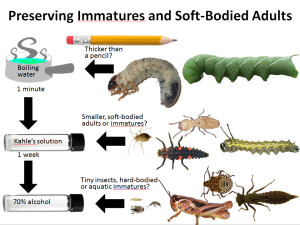Summary of Techniques for Alcohol Preservation
Boiling water (1 minute), then Kahle’s solution (1 week), then 70% Ethanol:
- Large, soft-bodied insects thicker than pencil
- Caterpillars, white grubs, maggots, larvae of bees and wasps.
First Kahle’s solution (1 week), then 70% Ethanol:
- Any mid-small sized, soft-bodied insect, adult or immature.
- Caterpillars, aphids, mealybugs, termites, leaf rollers, gall inhabitants, ant larvae, mosquito larvae
Straight into 70% Ethanol:
- Thrips, lice, springtails and other very small insects.
- Hard-bodied immatures such as the nymphs of grasshoppers and true bugs.
- Most aquatic immatures like dragonfly naiads, water pennies, hellgrammites, etc.
- NOTE: larger insects put directly into alcohol will turn black and not preserve as well.
DON’T FORGET THE LABEL:
- include a label in all vials, following these instructions.
Soft-Bodied Adults Typically Preserved in Alcohol
It is desirable to preserve most soft-bodied adults in alcohol, including members of the following taxonomic groups:
| Protura | Diplura | Collembola | Zygentoma |
| Archeognatha | Isoptera | Ephemeroptera | Psocodea |
| Thysanoptera | Siphonaptera | Hemiptera (aphids & scale insects) |
More Details …
Not all insects can be successfully mounted on a pin or a paper point. Some are just too small (like thrips and lice); others are too delicate or fragile (mayflies and silverfish, for example). Soft-bodied insects, such as aphids, and many immature stages (like maggots, white grubs, and caterpillars) will shrivel up and discolor or decompose if left to dry out on a pin.
For the purposes of this course, all immature stages, all soft-bodied adults, and all ridiculously small insects should be preserved in 70% ethyl alcohol (ethanol) and submitted in the glass vials supplied by your instructor. When your collection is graded, anything on a pin (or a point) is assumed to be an adult unless labeled otherwise. Anything submitted in a vial of alcohol is assumed to be an immature unless labeled otherwise. Example: an adult flea in alcohol should have an ID label reading, “Siphonaptera (adult)”.
Most hard-bodied immatures (like grasshopper nymphs, dragonfly naiads, wireworms, etc.) can go directly into a vial of 70% alcohol. Unfortunately, it’s not always possible to preserve the colors of these insects. Bright colors often fade over time and some pigments will “bleed out” into the alcohol. If the liquid becomes discolored, pour it off and replace it with fresh alcohol.
Soft-bodied insects tend to shrivel up in 70% alcohol. An osmotic pressure difference causes the specimen to dehydrate because water leaves the body faster than alcohol enters it. This can be avoided by “fixing” the specimen in Kahle’s solution (supplied by the instructor). After several days, pour off the Kahle’s solution (it is not a long-term preservative) and replace it with 70% ethanol. You can save the Kahle’s solution and reuse it for other specimens.
White grubs, maggots, and large caterpillars begin to decay rapidly when they die. Even in Kahle’s solution they will quickly shrivel and turn black. These specimens first need to be “poached” by dropping them (live or freshly killed) into a pan of boiling water. The hot water kills bacteria and coagulates the body proteins (like boiling an egg). After one minute, fish your specimen out of the boiling water and put it into a vial of Kahle’s solution. After 5-7 days, pour off the Kahle’s solution and replace with 70% ethanol.
Each vial should contain one Date/Locality label, one ID label, and if appropriate, one ecological label. Put the labels inside the vial with the specimen(s). Be sure to use permanent ink that is not soluble in alcohol. Do not store or transport your vials in the same box with your pinned specimens. If they get loose and roll around, your beautiful insect collection will become a box of bug crumbs!


